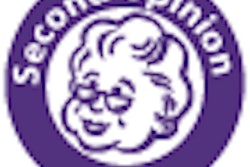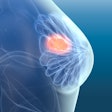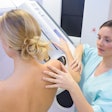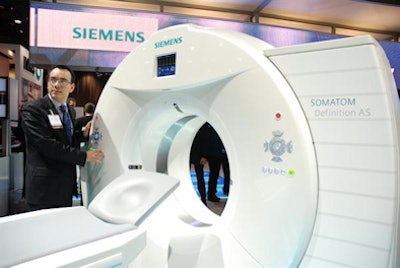
CHICAGO - A new hybrid PET/MRI scanner, as well as a recently cleared full-field digital mammography (FFDM) system and new CT dose-reduction packages, are pacing the RSNA launches in the booth of Siemens Healthcare of Malvern, PA.
PET/MRI
With the simultaneous acquisition of MR and PET data in an average scan time of 30 minutes, the hybrid imaging system, called Biograph mMR, is designed to provide morphological and functional details in human tissue with MR and investigate the human body at the level of cellular activity and metabolism with PET.
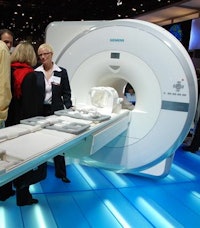 |
| A Siemens researcher demonstrates the Biograph mMR system. |
The system uses a 3-tesla MRI component and is currently undergoing clinical testing at the University Hospital "Klinikum rechts der Isar" of Munich Technical University in Germany.
Siemens expects to apply for 510(k) marketing clearance from the U.S. Food and Drug Administration (FDA) next year, with the possibility for worldwide distribution by the end of 2011.
Ultrasound
Siemens also is exhibiting a work-in-progress, real-time, stereoscopic 3D/4D imaging capability on its premier Acuson S2000 ultrasound system. The new product uses advanced visualization technology via Nvidia Quadro graphics cards.
Combined with new Nvidia 3D Vision Pro stereoscopic glasses, the display of volumetric information offers anatomic views beyond conventional 3D imaging techniques, according to the company. Also available off the ultrasound system using the syngo.fourSight Workplace, the new technology provides additional diagnostic information to enhance communication between surgeons and patients or to aid in treatment or surgical planning.
The Acuson S2000 ultrasound system also features Virtual Touch HD technology (not yet available in the U.S.), the second generation of acoustic radiation forced impulse (ARFI) imaging, and Cadence contrast pulse sequencing technology.
Siemens is also showing its Acuson X300 ultrasound system, premium edition (PE). This fully featured system includes high-end image optimization techniques, enhanced workflow features, and Cadence contrast agent imaging technology. It also has a new 17-inch high-resolution monitor for a larger image display without loss in image quality.
MRI
Siemens is combining its Tim (total imaging matrix) 4G and Dot (day optimizing throughput) technologies on the company's Magnetom Aera 1.5-tesla and Magnetom Skyra 3-tesla MRI systems.
Tim 4G is Siemens' fourth-generation version of its Tim radiofrequency (RF) and coil technology. It provides newly designed, ultrahigh-density coils combined with 48 RF channels, while the Dot engine features a customizable framework for patient personalization, user guidance, and exam automation.
Nuclear medicine
Siemens is also displaying its new Biograph mCT 20 Excel scanner, which features a 78-cm bore and can accommodate patients as large as 500 lb. Siemens plans to have the Biograph mCT 20 available for worldwide distribution in April 2011.
Biograph mCT 20, which offers 20-slice CT technology, includes high-definition PET, time-of-flight technology, and CT configurations up to 128 slices.
Healthcare IT
Siemens also launched its syngo.via imaging software for multimodality reading of clinical cases for enhanced reading efficiency across multiple specialties, including oncology, cardiology, and neurology.
Syngo.via interfaces with imaging devices, such as MRI, CT, and PET/CT scanners, and RIS and PACS from different vendors, along with Siemens' syngo.plaza PACS. When syngo.via and syngo.plaza are combined, users are provided no-click access between the two technologies and a unified user-interface for enhanced reading.
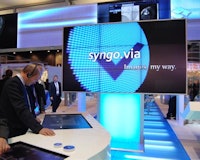 |
| Siemens has launched its syngo.via imaging software. |
Syngo.via's Case Navigator supports structured workflow by categorizing various workflow steps and aligning images to each corresponding step. During the reading process, findings and measurements can be automatically tracked and listed with the Findings Navigator, which allows users to effectively navigate between various findings with just one click.
CT
In the CT section of its booth, Siemens is highlighting new packages for reducing radiation dose and improving productivity, both major themes at this year's RSNA meeting. The company is also launching the next generation of its iterative reconstruction algorithm for reducing dose.
The new iterative reconstruction protocol is called Safire (sinogram-affirmed iterative reconstruction), and it represents an improvement over the company's first iterative reconstruction offering, Iris. Safire directly accesses raw data from the scanner, rather than images after they are reconstructed, as Iris does.
This results in lower noise compared to earlier generations of iterative reconstruction protocols, according to the company. Siemens estimates that 72% of all default scanning protocols with Safire can be performed with less than 2.4 mSv of radiation dose -- lower than the natural background radiation the average person is exposed to in a year. In addition, the speed of Safire reconstructions is close to those of normal reconstructions.
Siemens believes that with Safire, iterative reconstruction will become a routine scanning protocol, rather than being reserved for special dose-sensitive cases. Safire is pending 510(k) clearance and will begin shipping in the spring of 2011 for all of the company's Definition scanners. Iris, meanwhile, will be rolled out for older Siemens Emotion and Sensation scanners in the installed base.
On the application side, the company's new Care (combined applications to reduce exposure) kV reduces dose by using the CT system's scout scan to automatically set the optimal kV setting for an exam based on the patient's anatomy. Siemens notes that simply reducing kV levels from the standard 120-kV setting used in most scans to 100 kV can reduce dose by 20% to 30%. Care kV also selects the optimal mAs setting for the kV level, the company said.
Another new package in the Care suite, called Care Child, enables the use of kV settings as low as 70 kV, a level that previously hasn't been used, according to the company. Both Care kV and Care Child will begin shipping in the spring of 2011.
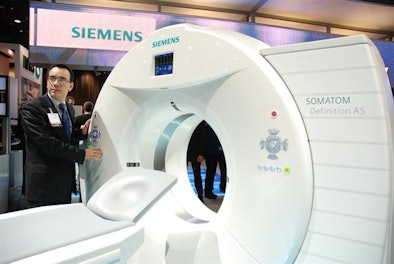 |
| The Somatom Definition AS scanner. |
Women's imaging
In the women's imaging section of Siemens' booth, company officials are celebrating the receipt in early November of premarket approval for the vendor's Mammomat Inspiration full-field digital mammography system.
Based on an amorphous selenium digital detector, Inspiration is designed for screening, stereotactic biopsies, and diagnostic work. The system's high throughput is demonstrated by the fact that some Inspiration users in Europe are averaging 15 screening exams per hour. Company officials estimate that U.S. throughput will be closer to seven to eight cases per hour.
Inspiration can be configured to technologist preferences, has push buttons on the x-ray tube head for settings, and is also available with special mood lighting as an option. The unit also supports needle biopsies in both vertical and lateral orientations.
Inspiration is also the platform for Siemens' 3D breast tomosynthesis technology -- indeed, the company has 70 3D tomo units installed in Europe (U.S. commercialization of tomo will have to await the filing of a regulatory application, and the feature is being shown at RSNA as a work-in-progress). As a tomo system, Inspiration collects 25 projection images over a ± 25° arc.
X-ray and angiography
In the realm of x-ray and interventional radiology, Siemens is showing a 17 x 17-inch flat-panel digital detector instead of a traditional image intensifier for its Luminos fluoroscopy system as a work-in-progress. Siemens believes that the configuration will make the unit more versatile for facilities that want to perform both fluoroscopy and radiography in a single system.
The firm is also showing a wireless digital detector on the Ysio radiography unit, touting the system's versatility, 500 preset imaging positions, and 660-lb patient table limit.
Siemens is adding features to its Artis zee product line for interventional imaging in radiology, cardiology, and surgery. The Artis zeego angiography system features a more flexible robotic-assisted C-arm and large-volume syngo DynaCT to allow physicians to see the whole abdomen or the entire liver for chemoembolization and biopsies. The enhanced mobility and flexibility of the Artis zeego's robotic arm is designed to reduce the need to reposition patients and is available as a field upgrade on currently installed systems.
The Artis line also features the Care application, which includes CareGuard to help interventionalists track patient skin dose. All Artis zee customers -- both existing and new --will receive the Siemens Care package as part of their upcoming software update process or upon new system installation.
Refurbished equipment
With the tough economy prompting more hospitals to consider buying refurbished equipment rather than new systems, Siemens is promoting this area of its business by focusing on the environmental benefits of refurbishing. The company noted that it sends to a landfill only 2% of the parts in systems it refurbishes, and Siemens has partnered with the World Wildlife Fund to plant trees in Indonesia as part of a program to offset CO2 emissions.
The company is also promoting the recent launch of a "scalable" refurbishing option that lets customers choose the level of refurbishing they want in an individual system.
By Wayne Forrest and Brian Casey
AuntMinnie.com staff editors
November 29, 2010
Related Reading
Siemens receives 3 EHR certifications, November 24, 2010
Siemens debuts Fast Care CT program, November 23, 2010
Siemens launches scalable refurb program, November 19, 2010
Siemens gets 510(k) for FFDM unit, November 18, 2010
Siemens wins U.K. PET/CT contract, November 17, 2010
Copyright © 2010 AuntMinnie.com







